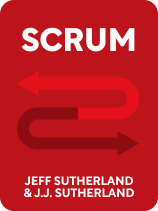

This article is an excerpt from the Shortform book guide to "Scrum" by Jeff Sutherland. Shortform has the world's best summaries and analyses of books you should be reading.
Like this article? Sign up for a free trial here .
What is the Scrum method? How is the Scrum method better than traditional management methods?
Although it’s widely used in software engineering today, the Scrum method was first introduced in 1995 by software developer and management expert Jeff Sutherland. Despite the fact that his book Scrum never took off, the Scrum method itself did.
Here’s a look at the Scrum method and its origins.
What Is Scrum?
What is the Scrum method? Scrum is a framework made to help people and organizations efficiently solve complex problems with creative solutions. Scrum is designed to be simple, and it’s based on a simple idea: When working on a project, check in regularly to make sure you’re heading in the right direction, and remove anything that might be slowing you down. The pillars of Scrum are incremental progress and adaptability rather than following a carefully prescribed plan. Applying the Scrum framework will help companies produce more value in less time by eliminating waste and maximizing time.
Jeff Sutherland is a software developer who created the Scrum method as a better way of developing products than the traditional methods. Published in 2014, Sutherland released Scrum almost twenty years after he first introduced the Scrum framework to the world in 1995. During this time, Sutherland refined and honed the Scrum method as he watched his ideas go from relative obscurity in the business world to the mainstream.
| How the Scrum Framework Remains Adaptable The Scrum framework emphasizes adaptability and as such, the framework itself is constantly evolving along with the rapidly changing worlds of business and technology. Sutherland, along with Scrum co-creator Ken Schwaber, regularly updates the Scrum Guide, which they first wrote in 2010. Sutherland and Schwaber last updated the Scrum Guide in November 2020, and they reiterate the idea that the Scrum framework’s simplicity allows it to be adapted and used across multiple fields and domains. Furthermore, this simplicity and adaptability allow the use of various processes and methods within the framework. For example, software company LinearB offers a free software tool that helps you further increase productivity, shorten development time, and increase employee fulfillment, building on the basic Scrum framework and adjusting it to suit their specific needs. |
Agile Methodology
Scrum builds on the agile business model, which Sutherland, along with sixteen other software developers, released with the Agile Manifesto in 2001. The Agile Manifesto recommends four strategies for product development:
- Focus on people, not procedures: Focus on people instead of procedures, because the people, not the plans, are the ones doing the work.
- Build working products instead of extensive documentation: Focus on making something that works instead of detailing what a product is supposed to do.
- Work with the customers: Since the goal of a business is to provide value to the customer, give the customer a chance to provide feedback and base your decisions based on what they want.
- Respond to change instead of adhering to a plan: Requirements for a product will almost always change throughout the development process. Focus on adapting to a changing environment, no matter how late in development you are.
(Shortform note: The principles of the agile business model are ubiquitous in modern business theory. Business Model Generation, for example, provides nine strategy techniques to help create or optimize a business model, many of which echo the strategies set forth in the Agile Manifesto. One technique recommends collaborating with customers before designing a product or service. Another technique builds on the agile principle of adaptation, suggesting you imagine future environments to better prepare your business to adapt.)
Scrum is the framework Sutherland built to put these values into practice.
Scrum Ideology
Sutherland took the term Scrum from an essay on which he bases many of his ideas, “The New New Product Development Game,” by Japanese business writers Hirotaka Takeuchi and Ikujiro Nonaka. Scrum, a rugby term, refers to the way a rugby team moves the ball down the field as a unit. An effective rugby squad works closely together with a clear goal in mind but numerous ways of achieving that goal. Like a rugby team, a Scrum team embraces creativity and unpredictability within a structured setting.
(Shortform note: Throughout Scrum, Sutherland uses sports stories and analogies to illustrate his points. Due to the hypercompetitive nature of the business world, it’s common among businesses to use sports metaphors in daily language and to look to sports strategies to help the company succeed. Some experts argue that this us versus them mentality, though it can seem motivational, can actually be damaging to your company. In Understanding Michael Porter, Joan Magretta argues that a company should be more focused on providing a valuable service than beating the competition.)
The Scrum framework is founded on two key principles: Learn through observation and root out and eliminate waste.
Learn Through Observation
The Scrum framework works by a constant scrutiny of the development process. Sutherland mentions a concept he learned in the Air Force known as the OODA loop. Developed for aerial combat by Air Force Colonel John Boyd, OODA stands for observe-orient-decide-act. As it pertains to product development, you observe your situation, assess your options, make a decision, and then act on it. As you repeat this process, you can make better decisions based on the constant inflow of new information.
(Shortform note: Colonel John Boyd, a famous military strategist, developed the OODA loop in the mid-20th century. Though it was originally designed for military combat, it has since made its way into various fields such as business, sports, litigation, and law enforcement. The theory behind the OODA loop is relatively simple: if you can quickly and clearly see what is going on around you, you can put yourself in a position to make quicker, more effective decisions. In combat, it can be the difference between life or death. In business, a company that successfully uses the OODA loop can gain a massive competitive advantage.)
Eliminate Waste
Many of Sutherland’s ideas are based on businessman Taiichi Ohno’s Toyota Production System, which defines three types of waste commonly seen in traditional production systems.
Taiichi Ohno identified three types of waste in a work environment:
- Waste through inefficiency. This refers to activities or processes that cost more than they are worth. This can include overproduction, overprocessing, inefficient transportation, too much time spent waiting, and many others.
- Waste through unevenness. This is caused by inconsistencies in production or workflow. It can be caused by management’s failure to implement proper standards, or by employees failing to follow standards properly.
- Waste through overburden. This refers to waste caused by a team trying to meet unreasonable demands. You want to keep your team working hard, but giving them too much to do for no reason will cause burnout and mistakes.
The Scrum framework addresses this waste by finding and eliminating inefficiencies in the work process, developing a consistent rhythm to the workflow, and challenging the workers in a realistic way.
| Ohno’s Seven Types of Waste and Just-in-Time Manufacturing Ohno released his book, Toyota Production System, in 1978. Most of Scrum’s ideas on waste and inefficiency lead back to this book. Ohno, however, identified seven types of waste, not three. Ohno’s seven types of waste are delay, overproduction, overprocessing, transportation, unnecessary motion, excess inventory, and defects. These are all problems Scrum addresses, but Sutherland chooses to categorize them differently than Ohno. Ohno’s theories on reducing waste have become a fundamental business strategy for many industries and have proven profitable. However, the philosophy is not without problems. Recently, the application of Ohno’s strategies on waste caused major problems in the supply chain. Derived from Ohno’s vision, just-in-time (JIT) manufacturing is a model that looks to minimize waste associated with overproduction. With JIT, manufacturers seek to meet demand without creating a surplus of product or raw materials. When Covid-19 upended expected supply and demand across the globe, JIT led to shortages in a wide variety of goods, further worsening the economic impact of the pandemic. |

———End of Preview———
Like what you just read? Read the rest of the world's best book summary and analysis of Jeff Sutherland's "Scrum" at Shortform .
Here's what you'll find in our full Scrum summary :
- Why the "Waterfall Method" leads to inefficiency and wasted money
- An explanation of the Scrum method and details on how to implement it
- How to use Sprints to get more work done






